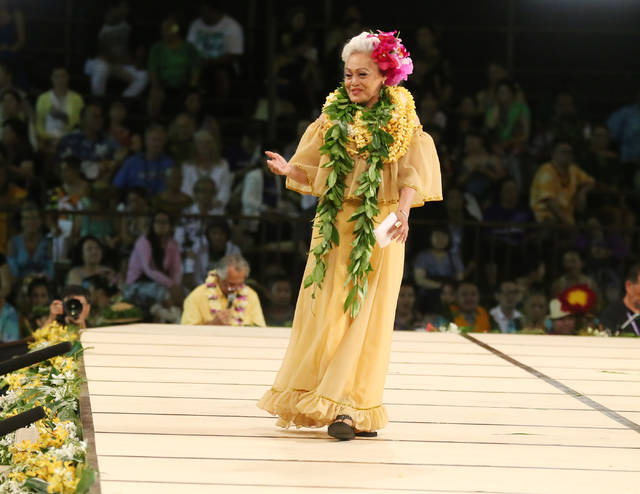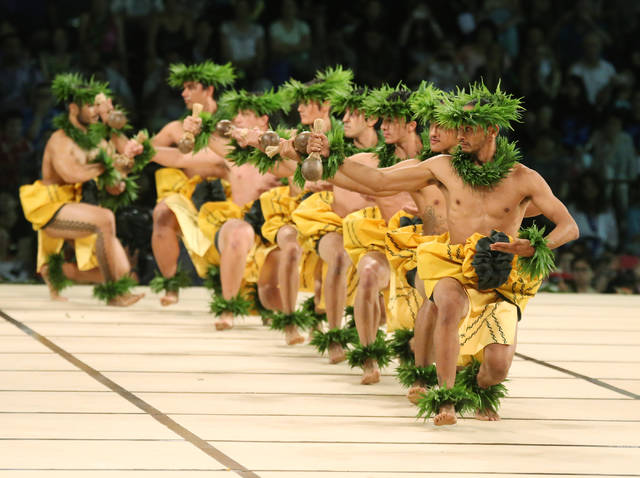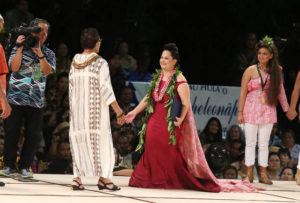Seven years after the death of beloved kumu hula Rae Fonseca, Halau Hula ‘O Kahikilaulani continues to perpetuate his legacy on hula’s most prestigious stage.
Seven years after the death of beloved kumu hula Rae Fonseca, Halau Hula ‘O Kahikilaulani continues to perpetuate his legacy on hula’s most prestigious stage.
Fonseca’s Hilo halau, now under the direction of kumu hula Nahoku Gaspang, has to be considered one of the favorites in this year’s Merrie Monarch Festival hula competition, with good reason.
In 2013, Kahikilaulani started its current run of collecting hula hardware at Saturday night’s awards ceremonies when its men took third place in the kane ‘auana (modern hula) and kane overall categories, and fourth place in the kane kahiko (ancient hula). The halau’s women also were rewarded by the judges, garnering fifth place in the wahine ‘auana category.
In 2014, the men followed up by taking the runner-up spot in kane ‘auana.
The men again served notice in 2015 with a second-place finish in kane ‘auana and a third-place tie in kane kahiko.
If perchance Kahikilaulani was flying under anyone’s radar, last year’s kane performances left no doubt the halau is a force to be reckoned with. The men took first place in kahiko, second in ‘auana and second in kane overall to Halau Na Mamo o Pu‘uanahulu, which won the overall and kane overall titles. Kahikilaulani came in third overall, with another Hilo troupe, Johnny Lum Ho’s Halau O Ka Ua Kani Lehua, winning the wahine overall title and taking the overall runner-up trophy.
“I’m very happy for both of us,” Gaspang said after the results were announced, a nod to her fellow Hilo kumu.
Kahikilaulani’s wahine have sat the past couple of years out while the kane bore the standard for the halau’s remarkable run, but this year both genders will compete before the hometown audience at Edith Kanaka‘ole Multi-Purpose Stadium.
Gaspang said she’ll have 19 women in her line, including “some young ones and new ones I’ve been working with.”
The wahine kahiko, “He‘eia,” is in honor of the festival’s namesake, King David Kalakaua, the Merrie Monarch. The best-known version of the mele was recorded in 1973 by Palani Vaughan on “Ia ‘Oe E Ka La, Helu ‘Ekahi,” the first of four albums honoring Kalakaua by the Hawaiian Music Hall of Fame inductee who died in December at 72.
“We went on a huaka‘i (cultural excursion) in Kona to learn about He‘eia, a surfing spot for Kalakaua,” Gaspang said. “It’s not the one in O‘ahu, but the one in Kona. (Kumu hula and Merrie Monarch judge) Etua Lopes shared his mana‘o (thoughts) with my girls, and also with me, about He‘eia. It was very, very hot. But it was a day of learning about what we were doing. Etua was very, very helpful to my mele.
“They learned about the ocean at He‘eia, and when you hear the ocean there, all you hear are the ‘ili‘ili rocks making that sound. So the girls listened to the sound, learning what they could observe from the ocean. And they started picking up ‘ili‘ili rocks from He‘eia, to make it more personal. I told them, ‘When you pick up that, that’s what you’re going to use for your mele.’
“Usually, people use ‘uli‘uli (feathered gourd rattles), but I decided to use ‘ili‘ili because when you go down to He‘eia, there’s nothing but ‘ili‘ili rocks.”
The mele for the wahine ‘auana is “Moku Ola,” which means “healing island.” Gaspang said musician Iwalani Apo gave her the idea. Aunty Lilinoe Keliipio Young, whose family used to live on the island in Hilo Bay also known as Coconut Island, educated Gaspang’s women about the island. Sheet music for the song was provided by legendary Hawaiian songstress Nina Keali‘iwahamana.
“Because there are no flowers on Moku Ola, I’m thinking about using the hala and the coconut for (adornment) for the girls’ hair,” Gaspang said. “And I’m putting them in a sarong, like the olden days. I found this book about Hawaiian fashion in the past — McInerny’s, Watamull’s. And the cover of the book has the sarong I’m going to use. And it’s like, wow!”
The men seek to enhance their enviable Merrie Monarch track record when they take the stage Friday for hula kahiko and Saturday for hula ‘auana. Kahikilaulani will have a young, small but mostly experienced group of kane dancers, eight for kahiko and seven for ‘auana, one of whom is 13, the youngest age allowed for a Merrie Monarch competition dancer.
Gaspang said the men’s kahiko mele, like the women’s, is a Big Island chant honoring Kalakaua. It is to honor Fonseca, as well, who brought the dance to the Merrie Monarch in the mid-1980s.
“I decided to bring it back with the ‘ulu‘uli,” Gaspang said. “My boys went to Kohala to learn about a place in their mele. Lorna Lim (of the legendary Kohala music and hula family) took them to share her mana‘o on the place.
“All the people who shared their mana‘o with us, I think that’s the beauty of it. We’re learning not only the mele, but the island that we live on, to know every part of the island.”
The kane ‘auana is “Pua Kukui,” a song credited to Mekia Kealakai contained in Johnny Noble’s “Collection of Ancient and Modern Hawaiian Hulas.” Gabby Pahinui recorded the song twice, first with the Sons of Hawaii, with a more contemporary take on the “Gabby Pahinui Hawaiian Band Volume 2” album.
The kaona (metaphoric subtext) of the lyric is of a lover as a cowboy on horseback using his lariat to lasso his budding kukui blossom’s fluttering heart.
“It’s a kolohe (rascal) number and my boys do well with kolohe numbers,” Gaspang said. “So when I read the mele, I went, ‘Oh, boy, here we go again.’ And they’re kind of excited to do it.”
The Kahikilaulani men are, in Gaspang’s words, “gung ho.” Their performances have the polish that comes with experience and the swagger that comes with recognition.
“I always tell our students it’s not about winning. It’s about showing what our legacy’s all about. You win, you win, you’ve tried. You lose, you lose, you’ve tried. That’s not why we learn hula. We learn hula because that’s our culture; that’s who we are.”
Email John Burnett at jburnett@hawaiitribune-herald.com.





